Villa also called "Officer's Villa"
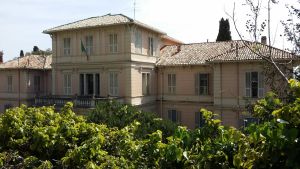
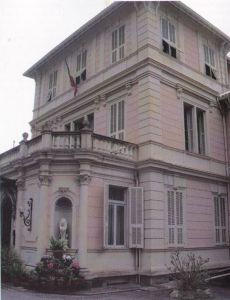 The villa, built in 1901 in the area of Corso Inglesi already occupied by an ancient anti-British tower, was designed by Pietro Agosti, who was commissioned by the English colonel Morgan Deril-Jumple Thorn, who had initially named it Villa Agnese in honour of his wife, Baroness Agnese di Groppello, and then changed its name to the present one.
The villa, built in 1901 in the area of Corso Inglesi already occupied by an ancient anti-British tower, was designed by Pietro Agosti, who was commissioned by the English colonel Morgan Deril-Jumple Thorn, who had initially named it Villa Agnese in honour of his wife, Baroness Agnese di Groppello, and then changed its name to the present one.
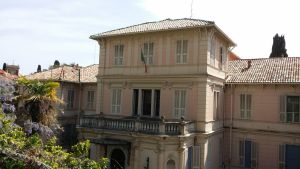 The building, whose main facade is livened up by the central tower, loggias and various terraces, is topped by a roof covered with curved polychrome majolica tiles, while the vast surrounding park is home to centuries-old trees, including pines, cedars and olive trees, firs, elms, cypresses, and flowers of
The building, whose main facade is livened up by the central tower, loggias and various terraces, is topped by a roof covered with curved polychrome majolica tiles, while the vast surrounding park is home to centuries-old trees, including pines, cedars and olive trees, firs, elms, cypresses, and flowers of 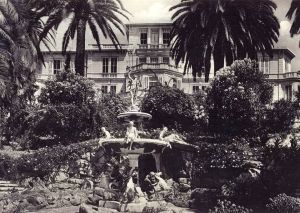 all species, there is a valuable bronze fountain (now stolen), designed by Agosti himself and structured in three basins above with sea horses, faunetti and a statue of the god Neptune at the top of the building.
all species, there is a valuable bronze fountain (now stolen), designed by Agosti himself and structured in three basins above with sea horses, faunetti and a statue of the god Neptune at the top of the building.
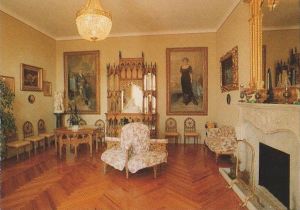 The interiors have preserved the sumptuous period decorations with polychrome marble floors in the large reception hall, walnut wood in the various living rooms, furniture, fireplaces, paintings, frescoes and stuccoes in pure gold beautifully preserved to decorate the various rooms.
The interiors have preserved the sumptuous period decorations with polychrome marble floors in the large reception hall, walnut wood in the various living rooms, furniture, fireplaces, paintings, frescoes and stuccoes in pure gold beautifully preserved to decorate the various rooms.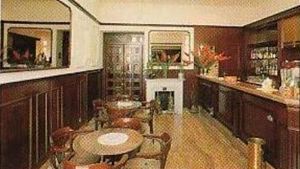
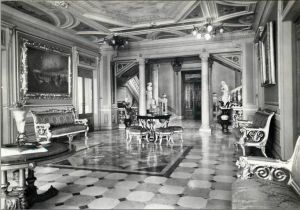 In the atrium two marble columns support the imposing staircase divided into two ramps that rest on the side walls.
In the atrium two marble columns support the imposing staircase divided into two ramps that rest on the side walls.
In 1912 Colonel Deril-Jumple sold the villa to his compatriot Thomas Lunbram Boyd, a wealthy merchant of Scottish origin, who was then working as a medical doctor for the numerous local British colony.
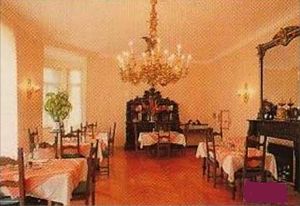 Among the works of art kept in the villa are the oil painting "Hunted from Paradise" by Gustave Doré (1832-1883), the "Battle of Sédan" by Pichat, the oil
Among the works of art kept in the villa are the oil painting "Hunted from Paradise" by Gustave Doré (1832-1883), the "Battle of Sédan" by Pichat, the oil 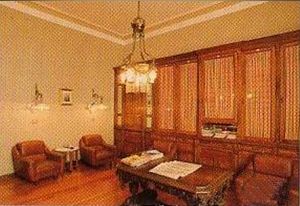 painting "Bay" by Bacher-Smith, a medium sized marble reproduction of Antonio Canova's masterpiece "Amore e Psiche", two Carrara marble statues representing as many female nudes sculpted by the Poison in 1866, marble busts of ancient Romans and Joan of Arc, precious chandeliers, valuable knick-knacks, crystal candelabra, two oil portraits of Thomas and Julia Catherine Boyde, as well as various baroque style marble fireplaces, one of which is very rare in black marble.
painting "Bay" by Bacher-Smith, a medium sized marble reproduction of Antonio Canova's masterpiece "Amore e Psiche", two Carrara marble statues representing as many female nudes sculpted by the Poison in 1866, marble busts of ancient Romans and Joan of Arc, precious chandeliers, valuable knick-knacks, crystal candelabra, two oil portraits of Thomas and Julia Catherine Boyde, as well as various baroque style marble fireplaces, one of which is very rare in black marble.
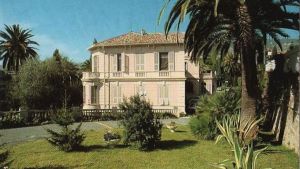 When Boyd died in 1931, he bequeathed the villa and all the property to his daughter Lady Daisy, widow of Sir Hasgille Ogle, who, on 29 March 1934, at the Italian Consulate in London, donated it with all the furnishings to Mussolini, as a token of her deep admiration and gratitude for the head of the Fascist government, which, however, renounced its personal use and arranged for it to be donated to the State Property Office, so that it could be used as a retirement home for retired and family-less officers, and assigned for perpetual use to the "Vittorio Emanuele III" National Charity Institute.
When Boyd died in 1931, he bequeathed the villa and all the property to his daughter Lady Daisy, widow of Sir Hasgille Ogle, who, on 29 March 1934, at the Italian Consulate in London, donated it with all the furnishings to Mussolini, as a token of her deep admiration and gratitude for the head of the Fascist government, which, however, renounced its personal use and arranged for it to be donated to the State Property Office, so that it could be used as a retirement home for retired and family-less officers, and assigned for perpetual use to the "Vittorio Emanuele III" National Charity Institute.
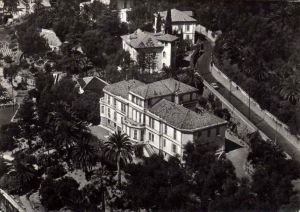 Until recently, the villa continued to house numerous retired officers, while in 1936 a new annexe had been erected in the park to allow more officers to stay in the structure.
Until recently, the villa continued to house numerous retired officers, while in 1936 a new annexe had been erected in the park to allow more officers to stay in the structure.
The complex was acquired a few years ago by the State Property of the Ministry of Defence and has been closed ever since, although it seems that the management has been entrusted to the UNUCI (Unione Nazionale Ufficiali in Congedo Italiani).
Visually today the abandonment is depressing.
(sources: Andrea Gandolfo "Guide to Artistic Heritage"; images from private archives)
LUCE movie about the Residence for Officers just established




